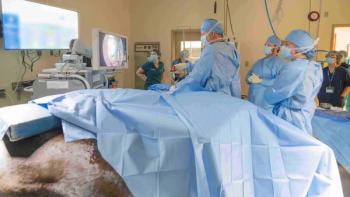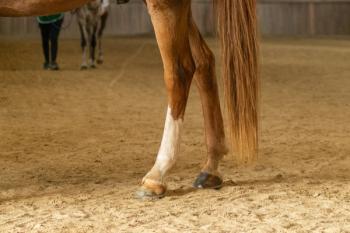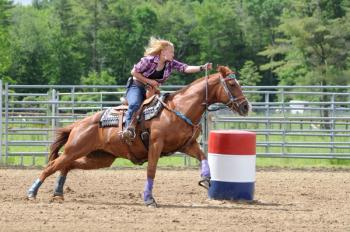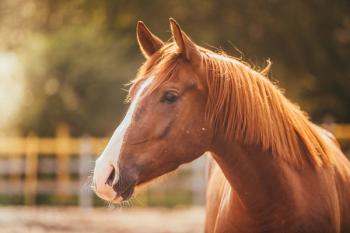
Updated on genetic disease in quarter horses and related breeds (Proceedings)
For diseases, there is a 'disease allele' (or gene mutation) and a 'normal allele' present in the population.
The Big '6' Genetic Disorders
1. HERDA
2. PSSM*
3. GBED*
4. HYPP
5. MH
6. OLWS
Allele definitions
• Allele – versions of a gene. Every animal has two alleles (one from each parent)
• For diseases, there is a 'disease allele' (or gene mutation) and a 'normal allele' present in the population.
• 'Allele frequency' is an estimate of the frequency of the disease allele in a population
HERDA
• Hereditary Equine Regional Dermal Asthenia
• Quarter horses and related breeds
• Collagen problem
• Seromas, hematomas and ulceration primarily along the dorsal aspect, some legs and other
• Progressive skin disease: age of onset: 1.5-2 years of age
• Skin has a hyperextensible quality
• Mutation identified: cyclophilin B gene (PPIB) (Tyron, et al Genomics 2007)
• Autosomal recessive
• Heterozygotes are clinically unaffected
PSSM
• Polysaccharide Storage Myopathy
• EPSM – Equine Polysaccharide Storage Myopathy
• Caused by a mutation in a gene regulating glycogen synthesis
o Glycogen synthase 1 (GYS1) gene mutation
• Accumulation of an abnormal glycogen in muscle cells
• This form of glycogen cannot be used for energy
• Leads to muscle stiffness, weakness, pain, poor performance and tying up
• Triggering events:
o Stress
o Weaning
o Onset of training
o Prolonged rest followed by work
o High grain (starch, sugar) diets
• Average age of onset of clinical signs is 5 years
• Affects a large number of breeds, but most common in:
o Quarter horses and related breeds
o Draft horses
• Dominant gene
o Only requires one copy of the gene for the horse to be affected
› Therefore, only one parent must carry the gene
• At least two forms of the disease in Quarter Horses
o PSSM type 1 – most common and has a genetic test
o Type 2 – no DNA test available yet
o Other forms?
Diagnosis
• Muscle biopsy – diagnosis of both forms of PSSM
o University of California
o University of Minnesota
• DNA test – currently only available for PSSM type 1
o University of Minnesota
Treatment/Prevention
• Decrease stress
• Keep the horses fit
o Regular exercise
o As much turn out time as possible
• Strict adherence to diet
o Low starch and sugar diet
• No grain/molasses
• Replace grain calories with fat sources
o Grass hays are the best hay source
o Vitamin E and selenium supplementation
GBED-Glycogen Branching Enzyme Deficiency
• "Glycogen Storage Disease IV"
• Stop codon in the glycogen branching enzyme gene (GBE1 gene)
• Affected animals produce an abnormal, less branched glycogen that cannot be utilized for energy
• The disease is lethal
• Recessive gene
o Carriers are phenotypically normal
o Affected foals die
• Causes abortion and neonatal mortality
• Foals are weak from birth
o Cannot regulate blood glucose
o Contracted tendons
o Muscle, liver, heart and lung problems
• All die by a few weeks of age
• Diagnosis:
o Genetic (DNA) test: University of Minnesota
• This disease is 100 % preventable
o Identify carriers and don't breed carrier to carrier
HYPP
• Mutation in the alpha-subunit of the muscle sodium channel gene
• Abnormal sodium channels don't close normally, leading to potassium-inducible episodes of muscle fasciculations, contraction followed by paralysis
• Semi-dominant trait
o Homozygotes are more severely affected than heterozygotes, but both affected
• Fasciculations, sweating, anxiety, respiratory noise
• Weakness, dog-sitting, paralysis
• Not a true seizure – horses are completely aware
• Homozygotes exhibit dysphagia or airway narrowing
• Both NH and HH horses can die during an episode due to complete airway closure or cardiac arrhythmias
Diagnosis and Treatment
• DNA testing – mandatory of all Impressive descendants in AQHA
• Management:
o Low potassium diet (< 1-1.5 % of diet) –No alfalfa, brome, molasses...
o Acetazolamide
o Minimize stress
o Small frequent feedings
o Regular exercise
• The AQHA has recently taken a stand to begin elimination of the trait.
• Beginning with the 2007 foal crop, any homozygous animals can not be registered.
• H/H horses are completely 100% avoidable
o Never cross NH to NH
Malignant Hyperthermia
• MH
• Newly recognized, still a lot to learn about this disease
• Dominant gene: Mutation in the Ryanodine Receptor 1 gene
• Homozygous state lethal in utero?
Clinical findings
• First cases were found under anesthesia
o High fevers (> 104 °F)
o Hypercontraction of muscles
o Rapid death with rigor mortis
• Now recognizing cases without anesthesia
o May appear relatively normal, although heavily muscled
o Stress seems to play a role with precipitating attacks
o Severe, rapid myositis (tie up)
o Persistent fevers and elevated muscle enzymes
• Well defined and heavy muscles
Diagnosis
• DNA test – University of California, Davis
o Dr Monica Aleman –Neuromuscular Lab
Overo Lethal White Syndrome
Ileocecocolic aganglionosis
OLWS
• All or nearly all white foals born to two frame overos or horse carrying the gene
• Normal at birth, but colic soon after
o Never pass meconium
o Develop abdominal distention
o Colic
o No treatment: surgical resection has been unsuccessful
• Semi-dominant gene
o Homozygous state of frame overo
OO
o Heterozygotes are frame overos
NO
• Mutation in the endothelin b receptor gene
o Responsible for neural crest cell migration to the skin (melanocytes) and to the gut (nerve cells)
• 25 % of frame to frame crosses will result in lethal white foals
Note: Not all white paint foals are lethal !
• Crosses of frame to sabino, splash, or tobiano or any other combination can produce all white foals
• Diagnosis of carriers: DNA test, UC Davis
• This disease is 100 % preventable
o Never cross two carriers
Available Genetic Tests
• Hyperkalemic Periodic Paralysis (HYPP)-1992
o UC Davis
• Lethal White Foal Syndrome (LWFS)- 1998
o UC Davis
• Glycogen storage disease IV (GBED)-2006
o UC Davis and Univ of Minnesota
• Hereditary Regional Dermal Asthenia (HERDA)- 2007
o UC Davis and Cornell University
• Polysaccharide storage myopathy (PSSM)-2008
o Univ of Minnesota
• Malignant Hyperthermia (MH)-2008
o UC Davis and Univ of Minnesota
Other Breeds:
Hereditary Junctional Epidermolysis Bullosa
Saddlebred horses
• Partial deletion of the LAMA3 gene
o Encodes for part of the Laminin 5 basement membrane protein
o Autosomal recessive
o Diagnostic test – 9/175 randomly selected America Saddlebreds born in 2007 were found to be carriers.
o Different gene than in Belgian draft horses (LAMC-2 gene), also of Laminin 5
o Testing: Gluck Equine Research Center, University of Kentucky
Cerebellar Abiotrophy of Arabians
• Purkinje cells, after they have been formed, die off
• Cerebellar signs predominate
• Autosomal recessive
• Signs vary in severity and timing
o May develop from birth to up to 4 months of age
• Indirect DNA test available –Identified genetic markers associated with CA
o Gene itself has not yet been identified
o Available at UC Davis Veterinary Genetics
References
Tyro RC, White SD, Bannasch DL. Homozygosity mapping approach identifies a missense mutation in equine cyclophilin B (PPIB) associated with HERDA in the American Quarter Horse. Genomics 2007; 90: 93-102.
McCue ME, Valberg SJ, Jackson M, et al. Polysaccharide storage myopathy phenotype in quarter horse-related breeds is modified by the presence of an RYR1 mutation. Neuromuscul Disord 2009; 19: 37-43.
Glycogen branching enzyme (GBE1) mutation causing equine glycogen storage disease IV. Mamm Genome 2004; 15: 570-577.
Aleman M, Nieto JE, Magdesian KG. Malignant hyperthermia associated with ryanodine receptor 1 (C7360G) mutation in Quarter Horses. J Vet Intern Med 2009; 23: 329-334.
Metallinos DL, Bowling AT, Rine J. A missense mutation in the endothelin-B receptor gene is associated with Lethal White Foal Syndrome: an equine version of Hirschsprung disease. Mamm Genome 1998; 426-431.
Rudolph JA, Spier SJ, Burns G, et al. Periodic paralysis in quarter horses: a sodium channel mutation disseminated by selective breeding. Nat Genet. 1992; 2: 144-147.
Finno CJ, Spier SJ, Valberg SJ. Equine diseases caused by known genetic mutations. Vet J 2009; 179: 336-347.
Newsletter
From exam room tips to practice management insights, get trusted veterinary news delivered straight to your inbox—subscribe to dvm360.




